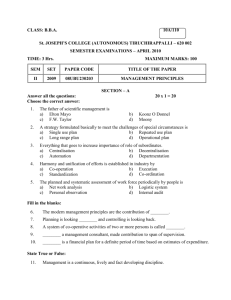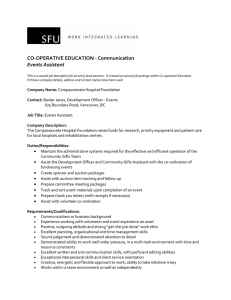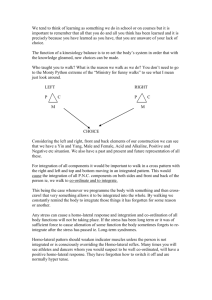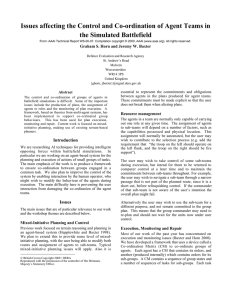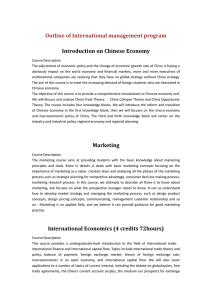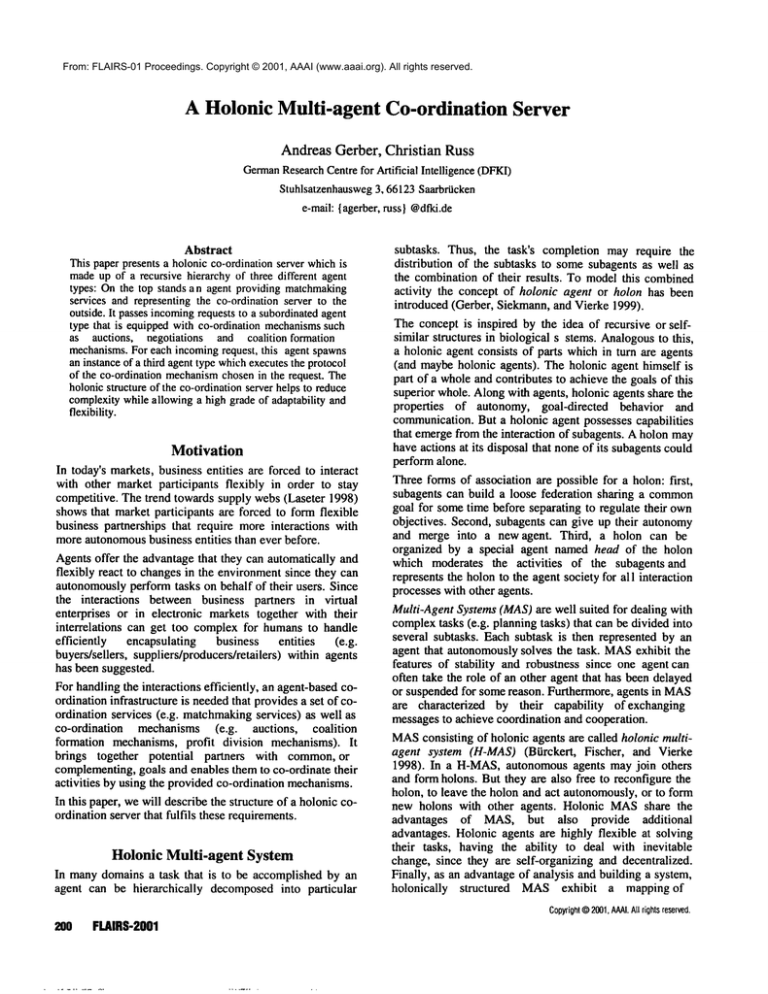
From: FLAIRS-01 Proceedings. Copyright © 2001, AAAI (www.aaai.org). All rights reserved.
A Holonic Multi-agent Co-ordination Server
Andreas Gerber, Christian Russ
German
ResearchCentrefor Artificial Intelligence (DFKI)
Stuhlsatzenhausweg
3, 66123Saarbriicken
e-mail: {agerber, russ} @dfki.de
Abstract
This paperpresents a holonicco-ordinationserver whichis
madeup of a recursive hierarchyof three different agent
types: Onthe top stands an agent providing matchmaking
services and representing the co-ordinationserver to the
outside. It passesincomingrequeststo a subordinatedagent
type that is equippedwith co-ordination mechanisms
such
as auctions, negotiations and coalition formation
mechanisms.For each incomingrequest, this agent spawns
an instanceof a third agent type whichexecutesthe protocol
of the co-ordinationmechanism
chosenin the request. The
holonicstructure of the co-ordinationserver helps to reduce
complexitywhile allowinga high grade of adaptability and
flexibility.
Motivation
In today’s markets, business entities are forced to interact
with other market participants flexibly in order to stay
competitive. The trend towards supply webs (Laseter 1998)
showsthat market participants are forced to form flexible
business partnerships that require more interactions with
more autonomousbusiness entities than ever before.
Agents offer the advantage that they can automatically and
flexibly react to changes in the environmentsince they can
autonomouslyperform tasks on behalf of their users. Since
the interactions between business partners in virtual
enterprises or in electronic markets together with their
interrelations can get too complex for humansto handle
efficiently
encapsulating business entities
(e.g.
buyers/sellers, suppliers/producers/retailers) within agents
has been suggested.
For handling the interactions efficiently, an agent-basedcoordination infrastructure is neededthat provides a set of coordination services (e.g. matchmakingservices) as well
co-ordination mechanisms (e.g. auctions, coalition
formation mechanisms, profit division mechanisms). It
brings together potential partners with common, or
complementing,goals and enables them to co-ordinate their
activities by using the provided co-ordination mechanisms.
In this paper, we will describe the structure of a holonic coordination server that fulfils these requirements.
Holonic Multi-agent System
In manydomains a task that is to be accomplished by an
agent can be hierarchically decomposedinto particular
subtasks. Thus, the task’s completion may require the
distribution of the subtasks to somesubagents as well as
the combination of their results. To model this combined
activity the concept of holonic agent or holon has been
introduced (Gerber, Siekmann,and Vierke 1999).
The concept is inspired by the idea of recursive or selfsimilar structures in biological s stems. Analogousto this,
a holonic agent consists of parts whichin turn are agents
(and maybeholonic agents). The holonic agent himself
part of a wholeand contributes to achieve the goals of this
superior whole. Alongwith agents, holonic agents share the
properties of autonomy, goal-directed behavior and
communication.But a holonic agent possesses capabilities
that emergefrom the interaction of subagents. A holon may
have actions at its disposal that noneof its subagentscould
perform alone.
Three forms of association are possible for a holon: first,
subagents can build a loose federation sharing a common
goal for sometime before separating to regulate their own
objectives. Second, subagents can give up their autonomy
and merge into a new agent. Third, a holon can be
organized by a special agent named head of the holon
which moderates the activities of the subagents and
represents the holon to the agent society for all interaction
processes with other agents.
Multi-Agent Systems (MAS)are well suited for dealing with
complextasks (e.g. planning tasks) that can be divided into
several subtasks. Each subtask is then represented by an
agent that autonomouslysolves the task. MASexhibit the
features of stability and robustness since one agent can
often take the role of an other agent that has been delayed
or suspended for some reason. Furthermore, agents in MAS
are characterized by their capability of exchanging
messagesto achieve coordination and cooperation.
MAS
consisting of holonic agents are called holonic multiagent system (H-MAS) (Btirckert, Fischer, and Vierke
1998). In a H-MAS,autonomous agents may join others
and form holons. But they are also free to reconfigure the
holon, to leave the holon and act autonomously,or to form
new holons with other agents. Holonic MASshare the
advantages of MAS, but also provide additional
advantages. Holonic agents are highly flexible at solving
their tasks, having the ability to deal with inevitable
change, since they are self-organizing and decentralized.
Finally, as an advantage of analysis and building a system,
holonically structured
MASexhibit a mapping of
Copyright
©2001,
AAAI.
Allrights
reserved.
2OO FLAIRS-2001
conceptual view and operational implementation. The
implementationreflects the conceptual structure.
Therefore, it seems to be a natural wayto represent many
organization forms in e-commerce(e.g. virtual enterprises,
supply webs) by a H-MAS
because the holonic agent-based
structuring supports their flexible and fluid formation as
well as their dissolving. Furthermore, as the partners of a
supply web the sub-agents of a holon have to pursue at
least one commongoal and thus show a commongoaldirected behavior.
A Holonie Co-ordination Server
The co-ordination server provides to the business agents in
a supply web or electronic marketplace a generic platform
with services, such as auction mechanisms, that enable
them to co-ordinate their interrelated activities ina
decentral fashion¯
Our co-ordination server is designed as an agent that can be
easily accessed by other agents for registration, requests,
etc..
Thearchitecture of this holonic co-ordinationserver is built
up of a three level hierarchy. Eachlevel contains a distinct
class of agents which are specialized in different ways¯
The co-ordination mechanismsare encapsulated into the
second and third levels¯ In the following, we describe the
functionalities of the three agent types that makeup the
hierarchy (see Figure 1).
..
z
variations,
etc.) from the CXs and propagate this
information together with the information about the
planned co-ordination processes upwards to the CMM
agent¯
The CMM
agent couples requesting agents (which want to
find or start an co-ordination for a given item) with the CX
agents. It stores the information about the CXagents in a
database and updates the information depending on the
status reports of the CMechagents¯ After it has matched
the request with its current database, the CMM
agent
simply returns a ranked list of relevant CXor CMech
agents to the requesting agent. The requesting agent then
has to contact and negotiate with the relevant CXor
CMechagents to get the services/items it desires. This
direct interaction betweenthe requesting agent and selected
CXor CMechagents is performed independently from the
CMM
agent (see figure 2). This avoids data transmission
bottlenecks, and even if a failure of the CMM
agent does
occur, running co-ordinations
would still work
Furthermore, the CMM
agent has additional functionalities,
e.g. to build a history about co-ordinations, their results and
the satisfaction of customersover time and goods.
~[CMM A~:ent]~..~
f’ Setter
]
~. "*-,_
¯ . -~
(I B.u.ye.r~
~
..-v-;-~---
¯
~
~
.." .-
"IoxA,.o,]"
-
Figure2. Agentrelationshipsby using the co-ordinationserver
The CMeehAgent
Figure!. Theholonicco-ordinationserver
The CMM
Agent
The co-ordination matchmaker agent (CMM)constitutes
the top of our hierarchy¯ It represents the co-ordination
server to the agents in the external market environment¯
The CMM
agent holds up-to-date data of all co-ordinations
run by subordinated agents and thus can match requests
about what service/item can be offered by using which coordination mechanisms.To get the information about the
co-ordination processes it stands in contact with its
subordinated co-ordination mechanismagents ( CMech).
The co-ordination mechanismagents are a meta-control
authority for all running, and planned, co-ordination
processes which are performed by so-called service
providing co-ordination execution agents ( CX)
The
CMechagents get the current information about the
running co-ordination processes (start, termination,
Thenext hierarchy level of our co-ordination server is built
up of CMechagents which are created with regard to the
kind of mechanismsthe co-ordination house wants to offer.
There are CMechagents for all kind of co-ordination
mechanisms, e.g. for the English-, Dutch- or Vickreyauction (Fischer, Russ, and Vierke 1998). If e.g. many
auctions are running at the same time, one single agent can
no longer handle all the requests in an efficient way. Thus,
the CMechagent does not execute any co-ordination on its
own.Instead it creates new CXagents which are speciall
designed to deal with a specific instance of a co-ordination
mechanismimposed by the CMechagent, e.g. an auction
for a certain good¯ If the existing CXagents are overloaded
the CMechagent can start a new CXagent which handles
the next set of co-ordination tasks what results in load
balancing through agent networks (Gerber 2000). Each
the CMechagents administrates a variable number of CX
agents which perform the same co-ordination mechanism.
Thus, these agents can be bundled into one holon per
mechanism. The holon is represented by an CMechagent
which is the head of the holon and co-ordinates the
distribution of the co-ordinationtasks to its subagents.
INTELLIGENT
AGENTS201
The CX Agents
The third level of the hierarchy contains CXagents which
are able to execute multiple co-ordinations of the same
mechanism.Only if such an agent is overloaded, another
agent of this type is created and may be started at/on
another place/computer in the co-ordination server
network, guaranteeing a good performance. If an coordination has ended the CXagent having performed the
co-ordination task will push the information about that coordination task to the CMechagent and to all participants
of that co-ordination task. The CMechagent forwards this
information to the CMM
which stores the information for
later use, e.g. statistic computations. After all coordinations of the CXagent have ended this agent might be
terminated if it is not neededanymore.
The realisation of this co-ordination server as a holonic
MAShas several advantages. Firstly, the holonic structure
allows to group independent, autonomous CMechand CX
agents, probabl ownedby different system designers and
located at different servers, by their functionalities to one
virtual auction server with clearly specified information
flows betweenits components.This conceptual structure is
open as well as flexible and enables as a second advantage
the flexible adaptation to dynamicchanging workloads, a
property called operator abstraction:When manyauctions
of the sametype are started one agent might not be able to
handle all these tasks alone. Other agents of the same type
could already running on other servers could join the
virtual auction holon or could be created on different
servers. Then, the tasks can be split up between them in
order to realize load balancing. To retain control over all
spatially as well as organisationally distributed auction
tasks superior co-ordination instances are necessar at the
first and secondlevel of the virtual auction server in order
to enable a global control over these tasks.
Interactions between the Agents of the Three
Levels of the Co-ordination Server
Wewill describe the interactions between the agents b
taking a look at an auction that could be initiated by a seller
and executed by the co-ordination server (see figures 2 and
3):
In the following we want to describe ho an auction can be
started .and performedby an agent society. A seller starts an
auction by sending an appropriate message to the CMM
agent. This messagecontains information about the item to
be auctioned off and in addition to that the seller’s
preferences concerning the co-ordination/auction
mechanisto be used and the auction monitoring services.
Then the CMM
agent triggers an appropriate CMechagent
whichspawns a CXagent for executing the auction.
After that the CMechagent transmits the address of the
spawnedCXagent back to the superior CMM
agent.
The CMM
stores the information about the started auction
in its database and sends the address of the CXagent
202
FLAIRS-2001
executing the auction to the seller, if the seller wants to
have auction monitoring (see the dotted line in figure 2)
access to the CX agent. Otherwise the CX agent
automaticall sends information about the auction state in
intervals to the seller.
While executing an co-ordination task, CXagents forget
that they are part of a holon and act as single agents. Thus
it is possible for co-ordinationparticipants to contact the
directly, this avoids the needto parse all messagesfromthe
head of the holon (CMM) down to the CX agents.
Therefore, the CXagents do not only have to push the
results of executed co-ordination tasks to their upper
CMechagent but also to all participants in that coordination.
Hencea buyer that is by chance interested in buying this
specific ite asks the CMM
agent if such an item is
currently attctioned off. The CMM
agent says yes to this
question and sends the address of the corresponding CX
agent stored in its database to the buyer. After that the
buyer registers at the CXagent and monitors as well as
bids in the auction.
After the auction has finished the CXagent reports its
outcome to the superior CMechagent that informs the
bidders about it.
The upper two levels of the hierarchy consist of holonic
agents whoselifecycles are not limited to any point of time.
The lowest level includes only agents whichdo not have to
exist all the time and can be created and terminated
dynamically.
Generally, by using a holonically structured hierarchy, all
incoming and outgoing messageshave to be transmitted to
the head (Gerber, Siekmannand Vierke 1999), i.e. the
CMM
agent in our server structure. But sending all
messagesto the head of the holon results in a very narro
bottleneck for the system, wherebyall co-ordination tasks
are slowed down. Thus our CMM
agent is only used for
performing co-ordination and information tasks within the
holon.
Sellel
(~,I~T-A~III
Cl~leclt ~,~ellt
BII3 er
CX-A~el|t
~tm’lCt
starl c.t.
stmt ¢.t.
c.l. ~talted
C.t *tllttetl
..........
6.t. Mh~llDd
~¢~tn~lit i-)~
, .~lat, e in DI3~
_e,.t..amtoa~l~
...........
lint ~lmlt
of ~-Iment
relliutw
a~lmowled~i©
bid
. J;,.t, .utmt~rJwt.
(:.t end
P~fm’ein DRI
¢ t - #~.ordlnatlon t~sk I
Figure3. Interactionbetween
sellers, buyersandthe coordinationserver agents
Market-based Supply WebCo-ordination
Mechanisms for the CMechAgents
Several market-based allocation mechanismsare suitable
for the co-ordination of supply web activities, e.g. the
allocation of a set of tasks to a set of supply chain agents.
Such mechanisms are the simulated trading algorith
(Bachem, Hochst~ittler, and Malich 1992) , the Vickrey
auction (Vickrey 1961), and the matrix auction for multiple
heterogeneous item (Gerber, Rul3, and Vierke 1999) .
compared their suitability,
using the allocation of
transportation tasks to a set of truck agents within the
multi-agent scheduling system MAS-MARS
(Fischer,
MOiler, and Pischel 1996) in a co-operative and
competitivesetting.
profits. The auctioneer agent represents the companyand
ries to minimizethe overall cost per order (see Figure 4).
An analogous setting in the supply web domain would be
the intraorganisational optimization of the supply flow by a
retail company.
Cost
Mechanism
6
15
30
60
90
120
Number of nrdlrl
Market-based Co-ordination
Mechanisms
Simulated Trading Simulated trading (ST) (Bachem,
Hochst~ttler, and Malich 1992) is a randomizedalgorith
that realizes a market mechanismwhere the participating
contractors optimize a task allocation by successivel
selling and buyingtasks. Trading is donein several rounds,
each of which consists of a numberof decision cycles. In
each cycle, the participants submit one offer to sell or buy a
task. At the end of each round the stock manager, the
central coordinating instance, tries to match the sell and
buy offers of the contractors such that the costs of the
global solution decrease.
In the sealed-bid second-price or Vickrey auction (VA)
(Vickrey 1961) every bidder submits a sealed bid for the
item to be auctioned off to the auctioneer. The bidder who
submitted the best bid receives the item for the second
highest bid made.In contrast to traditional auctions like the
English and Dutch auctions, this procedure is truth
revealing, i.e., it forces the bidders to submit bids that
equal their true valuationsfor the items.
Matrix auctions (MA)(Gomber, Schmidt, and Weinhardt
1998) are - in contrast to ST and VA- applicable for the
simultaneous assignmentof multiple items or
tasks to bidders. The auctioneer announces in a
matrix-k-auction (MA-k)the k offered items to the bidders
who, in turn, calculate their valuations for each potential
combinationof items and report themto the auctioneer.
From the transmitted bids or reported valuations of the
bidders the auctioneer identifies the optimal allocation of
all k items. The price for each assigned subset of items
equals the second-highest bid in the matrix columnfor that
set of items. Like the Vickreyauction, the matrix auctions
are truth-revealing.
Suitability
of the Mechanisms for Supply Web
Co-ordination Tasks
In the co-operative setting, the truck agents belong to one
companyand have no interest in optimizing their individual
Figure4: Overallcost per order
In the competitive setting, the truck agents represent
independent self-interested forwarders. They compete on
an open electronic
market for the assignment of
transportation tasks in order to optimize their route plans
and in this way their surplus per order. The auctioneer
agent does not represent a shipping companybut acts as an
independent broker. Youcan think of an analogous setting
in the supply web domain where some independent
companies form a short-term supply path, a virtual
companyor co-operate with other companies within the
frameworkof a strategic alliance.
In (Gerber, RuB, and Vierke 1999) , we empiricall
examinedthe scalability and tractability of the marketbased co-ordination
mechanisms mentioned above b
comparingtheir processing time and allocative efficienc
for order sets of different size. Thereby, the allocative
efficiency of the mechanismsis measuredin terms of cost,
and surplus.
In the cooperative setting - where cost per order is the
crucial issue -the simulated trading procedure produces
generally the best results with tractable effort. The
simulated trading procedure is proved to be most efficient
for large order sets where muchoptimization can be done.
MA-3and MA-4perform slightly better than the remaining
protocols. Hence, ST would be the protocol of choice for
the auctioneer. Nevertheless, MA-3achieves acceptable
results as well.
In the competitive setting - where individual agents tr
optimize their benefit - the individual surplus of the agents
taking part in the co-ordination process has to be compared
(Figure 5). In this setting ST is not applicable. Here, the
MA-2procedure ensures a maximal payoff for the selfinterested agents and outperforms dominantly all other
mechanisms,followed by the Vickrey auction.
In summary, especially ST, MA-2, and MA-3are ver
suitable for supply web co-ordination tasks and therefore
INTELMGENT
AGENTS 203
are integrated
into our supply web co-ordination
architecture.
With respect to the tractability of the mechanisms,the
evaluation showed that ST, VA, MA-2,and MA-3can be
rated as scalable, while MA-5and, for large order sets,
MA-4do not provide better results, but loose tractability,
indicating that matrix auctions where six or even more
items are traded in parallel are not expected to be
particularly efficient.
Dueto the space restriction wecould not present all results;
more results of the evaluation can be found in (Gerber,
Russ, and Vierke 1998).
Surplus
I
300
"
.
200
"~ :
150
¯
l""
. ".
. . ".
’l
¯
250
¯
.
i
.
.
[~Matrix3
r-] Matrix4
I
--
/
[
:u
6
I ¯ Matrix2
tmJaU
15
30
60
90
t20
Numberof orders
Figure5: Overallsurplusper order
Conclusion & Further Work
In this paper, we have presented a three-part agent-based
co-ordination infrastructure for supply webs. Wehave
already implementedthis infrastructure as well as suppl
chain agents in Java. First results in coordinatingthe suppl
activities of the agents by the use of the co-ordination
server and several co-ordination mechanisms,as the matrix
auction (Gerber, Russ, and Vierke 1998), simulated trading
(Vierke 2000) and the extended contract net protocol
(Vierke 2000), are very promising.
Our main goal is to extend the developedinfrastructure b
integrating more co-ordination mechanismssuch that the
agents can co-ordinate their activities moreefficiently b
using them. Therefore, our future activities will mainl
consist in the development of a set of agent-based coordination and negotiation mechanismsas well as their
integration in the co-ordination infrastructure.
The
developed mechanisms are intended to support the
configuration and co-ordination of distributed business
processes as well as the (re)allocation of r esources and
tasks within supply webs. Moreover, we will investigate
their effects on supply chain execution by applying themto
simulation scenarios.
The developed agent technology could be directly applied
in related areas, e.g. for implementingelectronic markets
and virtual enterprises. Our workhas been supported by the
European Union and the SAP subsidiary SAP Retail
Solutions.
204
FLAIRS-2O01
References
(Bachem, Hochsta’ttler, and Malich 1992) A. Bachem,
Hochst~ittler, and M. Malich. Simulated Trading: A Ne
Approach For Solving Vehicle Routing Problems.
Technical Report 92.125, Mathematisches Institut der
Universit"at zu K"oln, Dezember1992.
(Btirckert, Fischer, and Vierke 1998) H.-J. Biirckert,
Fischer, and G. Vierke. Transportation Scheduling with
Holonic MAS --The TeleTruck Approach. In:
Proceedings of the Third International Conference on
Practical Applications of Intelligent Agents and
Multiagents (PAAM’98),1998.
(Fischer, Miiller, and Pischel 1996) K. Fischer, J.
Miiller, and M. Pischel. Cooperative transportation
scheduling: an application domainfor DAI. Journal of
Applied Artificial Intelligence. Special issue on
Intelligent Agents,10(1 ), 1996.
(Gerber, Russ, and Vierke 1998) C. Gerber, C. Russ, and
G. Vierke. Anempirical evaluation on the suitability of
market-based mechanismsfor telematics applications.
Technical Report TM-98-02, GermanResearch Center
for Artificial Intelligence, 1998.
(Gerber, RuB, and Vierke 1999) C. Gerber, C. RuB, and
Vierke. On the Suitability of Market-Based Mechanisms
for Telematics Applications. In Proceedings of the
International
Conference on Autonomous Agents
(Agents’99), 1999.
(Gerber, Siekmann, and Vierke 1999) C. Gerber,
Siekmann, and G. Vierke. Flexible Autonomyin Holonic
Agent Systems. In Proceedings of the 1999 AAAISpring
Symposiumon Agents with Adjustable Autonomy,1999.
(Gerber, Siekmann, and Vierke 1999) C. Gerber,
Siekmannand G. Vierke. Holonic Multi-Agent Systems,
DFKI Research Report RR-99-03, ISSN 0946-008X,
Kaiserslautern 1999.
(Gerber 2000) C. Gerber. Self-Adaptation and Scalabilit
in Multi-Agent Societies, PhDThesis, Universitiit des
Saarlandes, Saarbrticken, 2000.
(Gomber, Schmidt, and Weinhardt 1998) P. Gomber,
Schmidt, and C. Weinhardt. Efficiency incentives and
computational tractability
in the coordination of
multi-agent systems. In Proceedings of the Workshop
Kooperationsnetze und Elektronische Koordination,
1998.
(Laseter 1998) T. M. Laseter. Balanced Sourcing:
Cooperation and Competition in Supplier Relationships.
Jossey-Bass, ISBN: 0787944432, October 1998.
(Vickrey 1961
W. Vickrey Counterspeculation,
Auctions, and Competitive Sealed Tenders. In: Journal
of Finance 16: 8- 37, 1961.
(Vierke 2000) G. Vierke. TELETRUCK
- A Holonic
Multi-Agent System for Telematics. PhD Thesis,
Universitiit des Saarlandes, Saarbriicken, 2000.


